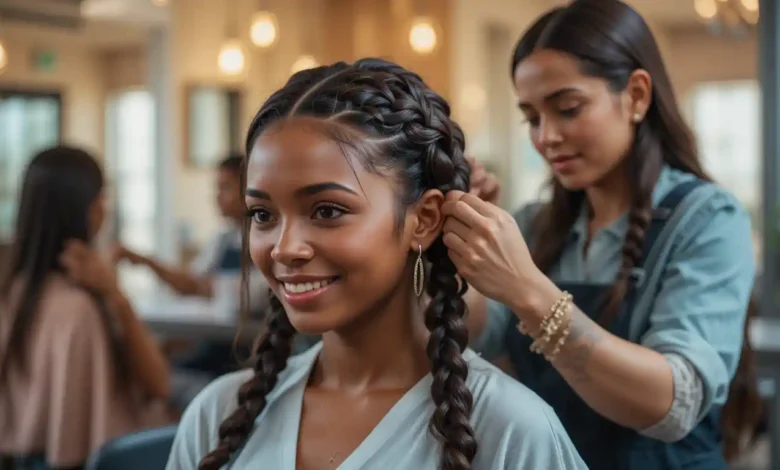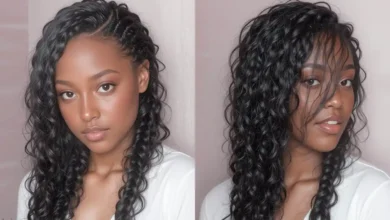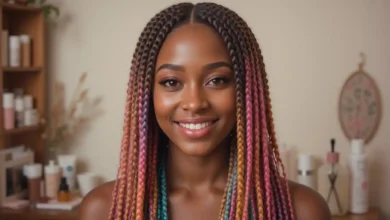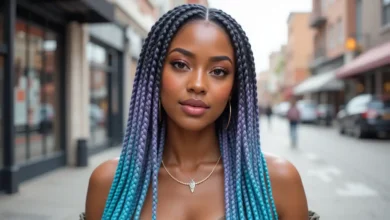Hair Braiding: A Comprehensive Guide to Styles, Techniques, and Benefits

Hair braiding is an ancient art form that transcends cultures and eras, with styles ranging from simple plaits to intricate designs. Whether it’s for aesthetics, convenience, or protection, hair braiding offers endless possibilities for individuals with various hair textures and lengths. In recent years, the popularity of hair braiding has grown due to its versatility and ability to promote hair health. This guide explores the different types of braids, techniques, benefits, and expert tips for maintaining braided hairstyles.
The History and Cultural Significance of Hair Braiding
Hair braiding has a rich history rooted in many cultures around the world. In Africa, hair braiding was used as a way to signify social status, age, and tribe affiliation. In other regions, such as Asia and Europe, braided styles were also worn to represent beauty, practicality, and tradition. As a hairstyle, hair braiding has evolved into a global phenomenon that crosses boundaries, maintaining its cultural importance while also becoming a fashionable choice for people of all backgrounds. This section delves into the historical and cultural significance of hair braiding, explaining how it has become a universal hairstyle.
Different Types of Hair Braiding Styles
There are numerous styles of hair braiding to suit different occasions, hair textures, and personal preferences. Some popular types include the classic three-strand braid, fishtail braid, French braid, and Dutch braid. For those seeking more intricate designs, styles like box braids, cornrows, and halo braids offer stunning alternatives. Each type of braid offers a unique look, and the variety ensures there is something for everyone. This section provides a detailed overview of the most common hair braiding styles, helping you find the right one for your hair type and lifestyle.
How to Braid Hair: Basic Techniques
Learning how to braid hair can be an empowering skill that opens up countless styling possibilities. While hair braiding can seem intimidating at first, mastering the basic three-strand braid is a great starting point. Begin by parting the hair into three equal sections and alternately crossing the outer sections over the middle one. With practice, you can progress to more complex techniques like French braiding, which involves gradually adding more hair to each section as you braid. This section provides step-by-step instructions for basic hair braiding techniques, making it easy for beginners to get started.
Benefits of Hair Braiding for Hair Health
Hair braiding offers several benefits for hair health, particularly for those with natural or textured hair. Braids can serve as a protective style, reducing exposure to environmental elements like sun, wind, and pollution. Additionally, hair braiding minimizes daily manipulation, which helps prevent breakage and promotes hair growth. Properly maintained braids can lock in moisture, making them ideal for those looking to maintain the health and strength of their hair. This section explores the key benefits of hair braiding, focusing on how it protects and nourishes the hair.
Hair Braiding for Different Hair Types
Not all braids work the same for every hair type, and it’s important to choose hair braiding styles that suit your texture. For instance, people with thick, curly, or oily hair may benefit from larger braids like box braids or cornrows, which help maintain their hair’s natural texture. On the other hand, those with fine or straight hair may prefer styles like French or fishtail braids, which offer a sleeker appearance. This section guides on selecting the right hair braiding technique based on your hair type, ensuring you get the best results and maintain hair health.
Maintenance Tips for Braided Hairstyles
Once you’ve styled your hair into braids, proper maintenance is essential to keep it looking fresh and to avoid damaging your hair. Regularly moisturizing your scalp, protecting your braids at night with a satin bonnet or pillowcase, and avoiding excessive tension are key factors in keeping your braids intact. It’s also important to cleanse your scalp gently to avoid product buildup. This section provides detailed maintenance tips for hair braiding, helping you extend the lifespan of your braided hairstyle while keeping your hair and scalp healthy.
How Long Do Braided Hairstyles Last?
The longevity of a hair braiding style depends on the type of braid, how well it’s maintained, and the individual’s hair texture. Simple braids, like a three-strand braid or fishtail, typically last for a day or two, while more intricate styles like box braids or cornrows can last for weeks with proper care. However, it’s essential to avoid keeping braids in for too long to prevent matting or hair damage. This section discusses how long different hair braiding styles typically last and how to know when it’s time to remove them.
Hair Braiding for Special Occasions
Hair braiding can elevate your look for special occasions, whether it’s a wedding, prom, or formal event. Elegant styles like the crown braid or halo braid offer a sophisticated yet timeless appearance, while fishtail or waterfall braids add a touch of whimsy. Many men and women opt for braided styles that complement their attire and enhance their natural beauty during important events. This section highlights popular hair braiding options for special occasions, inspiring formal looks that are both stunning and functional.
Hair Braiding as a Professional Service
While many people enjoy braiding their hair at home, professional hair braiding services are widely available for those seeking more intricate or long-lasting styles. Licensed braiders can create complex designs like box braids, Senegalese twists, or intricate cornrows, which require expertise and skill. Professional braiders also offer advice on hair care and maintenance, ensuring that your braids not only look great but also promote healthy hair. This section explores the benefits of seeking professional hair braiding services and what to expect when visiting a braiding salon.
Conclusion
Hair braiding is more than just a hairstyle—it’s a time-honored tradition that continues to evolve with new styles and techniques. Whether you’re looking for a protective hairstyle, a fashion-forward look, or a simple way to keep your hair neat, hair braiding offers endless possibilities. By understanding the different braiding techniques, learning how to maintain your braids, and selecting the right style for your hair type, you can enjoy the many benefits that come with braided hairstyles. With its rich history and modern appeal, hair braiding is a versatile and valuable skill that anyone can learn and enjoy.
FAQ
1. How long should I keep my braids in?
The duration of your hair braiding style depends on the type of braid. Simple braids may last a day or two, while more complex styles like box braids or cornrows can last anywhere from 2-8 weeks. It’s essential not to keep braids in for too long to avoid breakage or matting.
2. Can hair braiding damage my hair?
When done correctly, hair braiding can protect your hair and promote growth. However, if the braids are too tight or left in for too long, they can cause tension and damage. Proper maintenance and avoiding overly tight braids can help prevent damage.
3. How can I keep my scalp moisturized with braids?
To keep your scalp moisturized while wearing hair-braiding styles, use a lightweight oil or moisturizing spray designed for braided hair. Apply it to your scalp every few days to prevent dryness and itching.
4. Can I wash my hair with braids?
Yes, you can wash your hair while wearing hair-braiding styles. Use a diluted shampoo or cleansing spray to gently clean your scalp, and follow up with a conditioner or leave-in treatment to keep your hair hydrated.
5. What are the best braiding styles for short hair?
Short hair can be braided into styles like cornrows, mini braids, or a simple three-strand braid. These hair braiding options work well with shorter lengths and can be adapted to create stylish and manageable looks.





